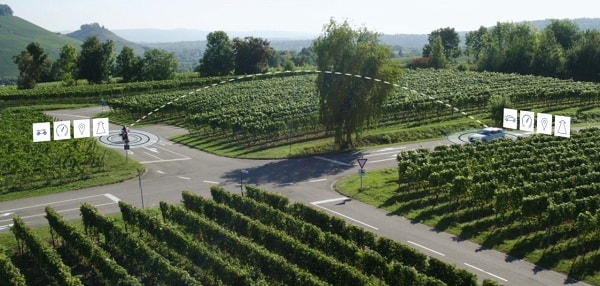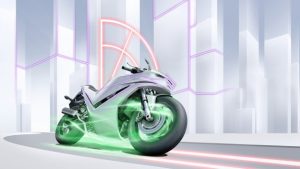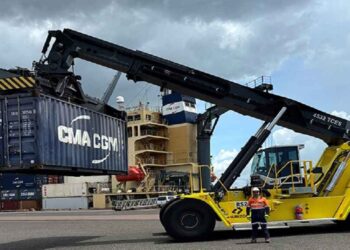Safety is one of the most urgent challenges in the motorcycle market. Whether smart assistance systems or connectivity packages, Bosch offers many solutions that make roads safer for motorcyclists. And with its innovative research projects, it is already planning for the next stages of development.
Whether wet leaves, an oil spill, or gravel on the road surface, wheels begin to slip sideways if they can no longer apply sufficient lateral force in a curve. In situations such as these, motorcyclists have practically no chance of righting their bikes. Ideally, keeping them safely on course would require applying additional external lateral force. This is the idea behind the sliding mitigation Bosch is developing in a research project. Like a magic hand, it keeps the motorcycle on track and considerably reduces the risk of a fall. A sensor detects sideways wheel slip. If a certain value is exceeded, gas is released from a gas accumulator of the type used in passenger-car airbags. The gas flows into the tank adapter and is vented in a certain direction through a nozzle. This reverse thrust keeps the motorcycle on track.

Radar-based assistance systems:
Giving motorcycles radar as a sensory organ enables these new motorcycle assistance and safety functions while providing an accurate picture of the vehicle’s surroundings. As a result, these assistance functions not only increase safety, they also enhance enjoyment and convenience by making life easier for riders.
ACC adaptive cruise control
Riding in heavy traffic and maintaining the correct distance to the vehicle in front takes a great deal of concentration and is strenuous over longer periods. ACC adjusts the vehicle speed to the flow of traffic and maintains the necessary safe following distance. This can effectively prevent rear-end collisions caused by insufficient distance to the vehicle in front. And not only does ACC offer riders more convenience, it also allows them to concentrate more on the road, particularly in high-density traffic.
Collision warning system
In road traffic, even the briefest lapse in concentration can have serious consequences. Bosch has developed a collision warning system for motorcycles to reduce the risk of a rear-end collision or to mitigate its consequences. The system is active as soon as the vehicle starts and it supports the rider in all relevant speed ranges. If the system detects that another vehicle is dangerously close and the rider does not react to the situation, it warns the rider by way of an acoustic or optical signal.
Blind-spot recognition
This system keeps a lookout in all directions to help motorcyclists change lanes safely. A radar sensor serves as the blind-spot recognition system’s electronic eye, registering objects in hard-to-see areas. Whenever there is a vehicle in the rider’s blind spot, the technology warns them by way of an optical signal – for example, in the rear-view mirror.
ABS:
Since 1984, Bosch has been continuously perfecting motorcycle ABS technology in order to make this important safety technology available for all vehicle classes in every market. According to Bosch accident research, roughly one in four motorcycle accidents involving fatalities and injuries could be prevented if all two-wheelers were fitted with ABS. Worldwide, more and more countries and regions, including the EU, Japan, Taiwan, and Brazil, are mandating motorcycle ABS. Since April 2018, motorcycle ABS is mandatory in India for all new two-wheeler types with an engine displacement above 125 cc. ABS 10 was designed specifically to meet the requirements for motorized two-wheelers in emerging markets.
MSC:
MSC motorcycle stability control is the world’s first all-in-one safety system for two-wheelers. By monitoring two-wheeler parameters such as lean angle, the system can instantaneously adjust its electronic braking and acceleration interventions to suit the current riding status. In this way, the Bosch system can prevent the bike from lowsiding or righting itself suddenly and uncontrollably when braking in bends, which is where the majority of motorcycle accidents occur. The new 6D sensor in the MSC system is the smallest and lightest design on the market. It significantly improves mounting flexibility, and is less prone to vibration.
 Motorcycle-to-car communication:
Motorcycle-to-car communication:
By enabling motorcycles and cars to communicate with each other, Bosch is creating a digital shield for motorcyclists. Up to ten times a second, vehicles within a radius of several hundred meters exchange information about vehicle type, speed, position, and direction of travel. Long before a motorcycle comes into view, this technology warns drivers and the sensors in their vehicles that a motorcycle is approaching. This allows them to drive better and more defensively. The public WLAN standard (ITS G5) is used as the basis for the exchange of data between motorcycles and cars. Transmission times of just a few milliseconds between transmitter and receiver mean that participating road users can generate and transmit important information relating to the traffic situation.
Emergency call, breakdown call, and information call:
On the basis of intelligent crash algorithms, eCall detects when a motorcyclist is involved in a crash, automatically transmits an emergency call, and informs the emergency services about the type of vehicle and its position. In the event that the two-wheeler breaks down, the bCall independently contacts the repair shop and sends the necessary data. The iCall is a helpful assistant on any road. This makes accessing service information – such as the location of the nearest gas station – simple and straightforward.


































